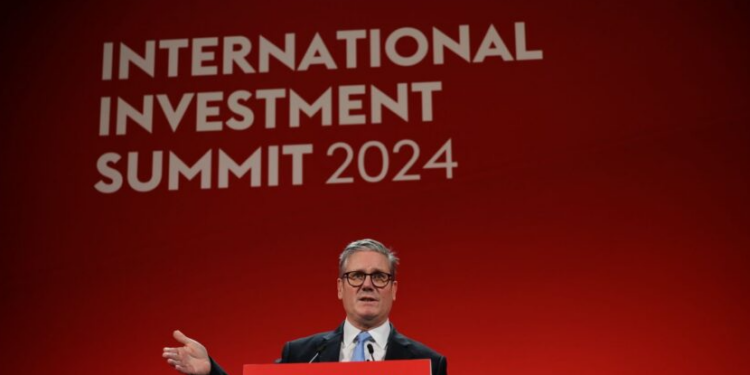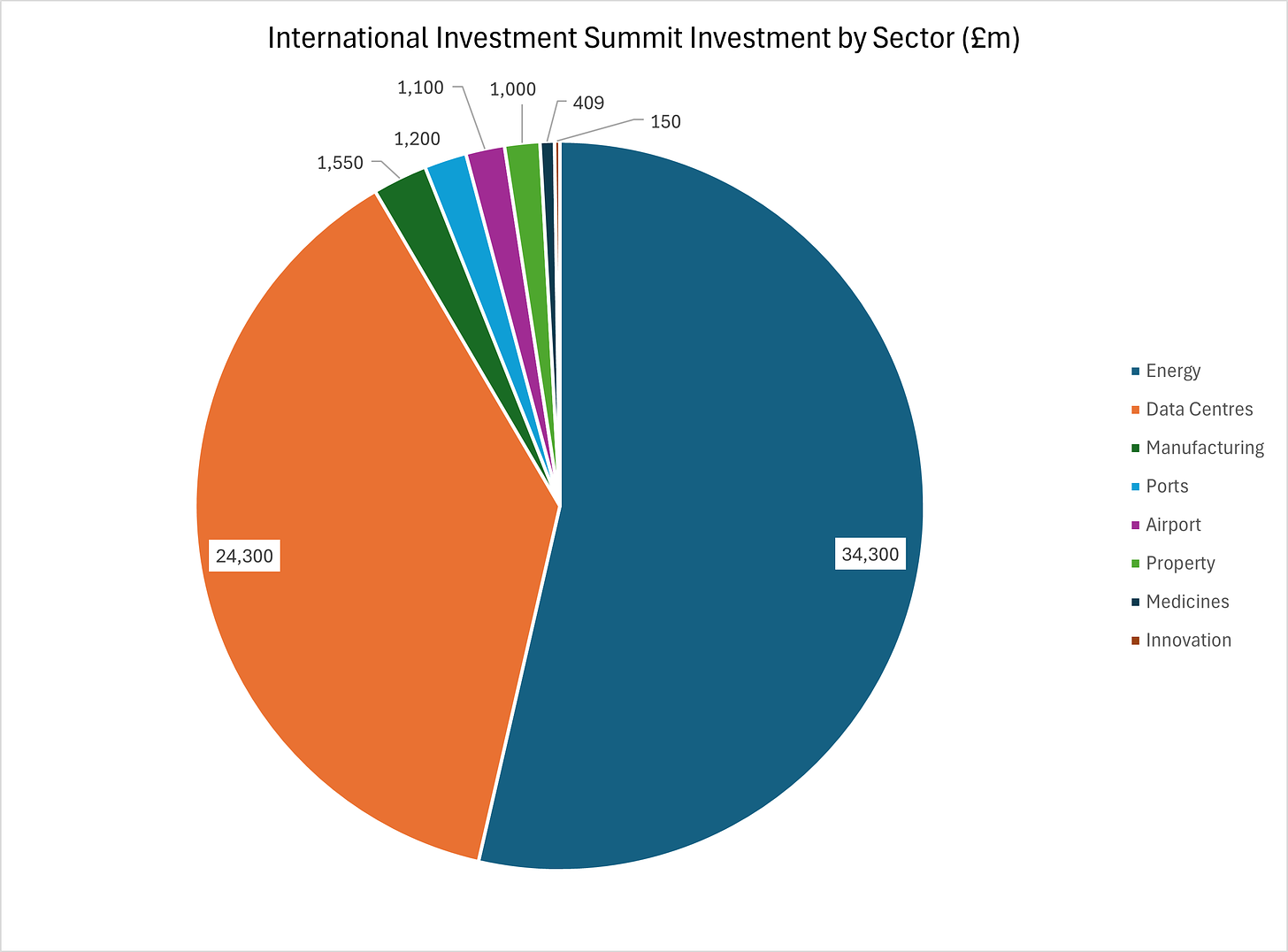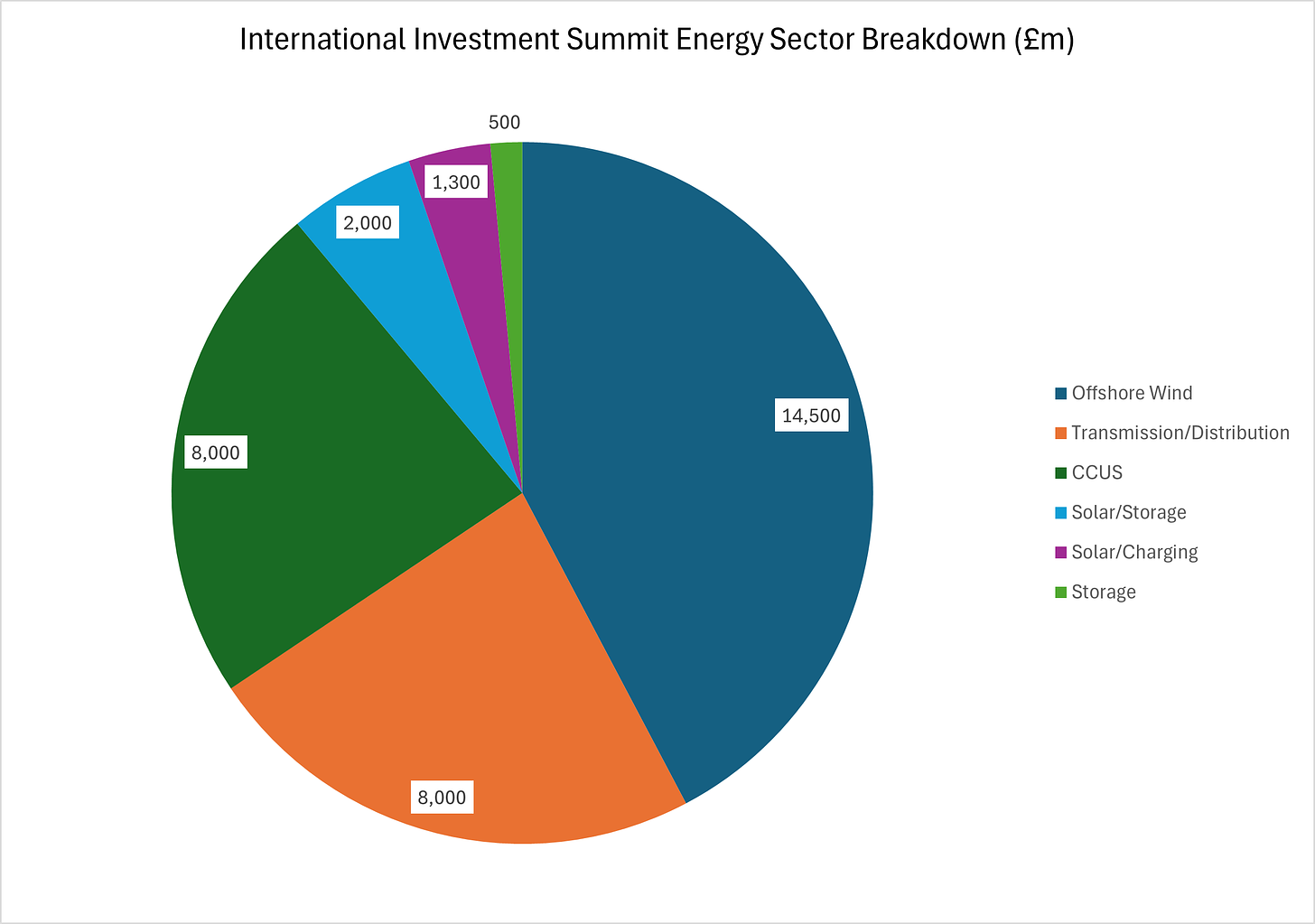The Government recently announced the results of the International Investment Summit held earlier in October with much fanfare. It claims the summit has secured £63bn of investment and nearly 38,000 jobs. But how much of this investment is really new, and what will be the impact on consumers?
International Investment Summit Sector Breakdown
The Government announcement lists 23 different items of investment across several industrial sectors as shown in Figure 1.
By far the largest sector is energy, taking £34.3 billion of the total £64 billion investment. The second largest sector is data centres with £24.3 billion. The remaining 8.5% of investment is spread across ports, airports, property, medicines and what I have loosely termed innovation.
How Much is New Investment?
However, the headline announcement is not quite what it seems. Many of the projects have been announced before. At least £39.6bn or 61.9% of the investment has been announced before as shown in Figure 2.
For instance, one of the largest project re-announcements is Blackstone’s £10bn data centre investment in Blyth was agreed in April 2024, under the last Government (see Figure 3).
Similarly, Ørsted’s £8 billion offshore wind investments were announced as part of the AR6 auction results last month and the AR6 process was initiated under the Tory administration, as was Greenvolt’s £2.5 billion floating offshore wind farm. Moreover, the £8 billion of carbon capture projects were announced by the then Tory Energy Minister, Claire Coutinho in October 2023.
Amazon’s £8 billion data centre investment was announced last month, seemingly totally unrelated to the investment summit. It also appears that not all the £8 billion will be “investment” because the press release says the money will be spent on “building, operating and maintaining” the data centres. The operating costs of large data centres are considerable because of the amount of electricity they consume. The claim of supporting 14,000 jobs also appears dubious because it seems to include tech jobs at clients that might utilise Amazon’s cloud services.
Planning permission for the £1.1 billion investment in expanding Stansted was granted in October last year, and Stansted is owned by Manchester Airports Group which is in turn owned by a consortium of Manchester local authorities so should not count as international investment. Finally, the Holtec SMR factory was announced in May 2024, it’s just the final site selection that was announced last month.
That leaves us with the remaining £24.4 billion of investment that might be termed new, but £2 billion of that is from U.K. business Octopus Energy. A further £1 billion is from a new property company set up by publicly owned Network Rail and London and Continental Railways; again, hardly international investment. It is also likely that many of these transactions would have happened without the lavish summit.
Impact of Energy Investments
The Chancellor, Rachel Reeves made a speech at the summit and claimed that the “Government’s number one mission is to grow the economy by being the most pro-business this country has ever seen”. It is interesting that she chose the words “pro-business” and not “pro-market”. We can perhaps see why if we dig into the announcements related to energy (see Figure 4).
The offshore wind projects were announced last month as part of the AR6 renewables auction results. As I covered then, the strike price for fixed offshore wind was in the range £76-£82/MWh (in 2024 prices), both of which are above the average reference price so far this financial year of around £61/MWh, largely set by gas. The generators are guaranteed subsidies that will be paid by consumers. The capital expenditure for the Ørsted projects is £8 billion to deliver 3.48GW of generating capacity, or £2.3 billion per GW. Moreover, the Greenvolt floating offshore wind project has a strike price of £195/MWh, more than three times the recent reference price. The capital expenditure for this project is £2.5 billion for a 400MW generator or £6.25 billion per GW. Both projects are spending far more than £1.4 billion per GW the Government estimated for offshore wind deliverable in 2030. These staggering costs will be paid by consumers through their bills.
The investment in Carbon Capture and Storage (CCUS) is estimated at £8 billion. However, in return for the £8 billion investment, the Government has confirmed that £21.7 billion of funding has been made available over 25 years for these projects. This means that consumers or taxpayers will be on the hook to pay back nearly three times the initial investment in subsidies to make these projects work.
Of course, the billions to be spent on storage will not generate a single extra MWh of electricity. Indeed, after taking account of losses during charging and discharging, the batteries will consume energy. Adding extra expenditure to the system without increasing output can only increase system costs and thus push up our bills even further. The £8 billion to be spent on transmission and distribution will also have to be paid back through higher network charges on our bills.
Data Centre Challenges
The second biggest investment category is in data centres. However, there are significant challenges ahead for these projects.
First, there is the problem of obtaining grid connections, with the system already operating at capacity across many areas of the country, including the area with most datacentres – the “Slough Availability Zone”. Second, even if connections can be delivered there has to be significant doubt that we are capable of generating sufficient electricity to power the hyper-scale 1 GW or higher behemoths that are under consideration to support the AI revolution. Third, as previously discussed, we are not cost competitive because the U.K. has the highest industrial electricity prices among the 28 developed countries covered by the IEA.
There must be grave doubts, despite the investment summit fanfare, whether these projects will be delivered on time or ever.
Conclusions
Overall, the investment summit was a damp squib, mostly re-announcing projects that were already in existence. Not only that, the energy projects that were declared will only increase our already extortionate electricity costs, making the country less competitive and act as a drag on growth.
However, it is revealing that the Chancellor declared her Government to be “pro-business”. We can see this means distorting the market to give corporations guaranteed returns at the expense of the consumer and taxpayer. It is astonishing that the Labour Party, supposedly the party of working people, is actively encouraging corporatism. Labour has become a kind of reverse Robin Hood, robbing the poor to give even more to the already rich.
David Turver writes the Eigen Values Substack, where this article first appeared.


















To join in with the discussion please make a donation to The Daily Sceptic.
Profanity and abuse will be removed and may lead to a permanent ban.
Almost all of this woke nonsense is coming from children who’ve been groomed by delusional lefties. Time for the adults to say ‘NO’.
It’s ‘Lord of the Flies’ only with adults not wanting to take charge and just encouraging the children.
There is no noticeable difference, except size, between adults and children. Since the 1980 children have not progressed emotionally and intellectually beyond the age of two.
Dawkins is confronting the consequences of his actions.
He showed his arrogance and at the same time his naivety in his book “The God Delusion” in which he must have thought he was being terribly clever comparing the belief in god to the belief in the flying spaghetti monster.
He failed to consider properly what useful functions religions play in society beyond what he thinks are childish attachments to god figures. Well now he knows. A society untethered from any religion will… produce a religion. And this one wants to stop him from using words he likes and tell him how he wants to think.
Religions clearly go through authoritarian phases and they need to be “tamed” – for lack of a better word. Christianity in Britain in the late 20th century was completely tamed and for the most part a harmless institution giving some stability to our society. Dawkins did his bit to destroy what was left of it. He can now deal with what has grown in its place.
Another example of a clever person who is actually a bit stupid.
There are hundreds of gods, but don’t worry! – yours is the best!
There are hundreds of theological and atheistic beliefs, Marcus, but don’t worry – yours is the best!
Atheism is not a belief, it is an absence of belief.
Atheism is a faith that there is no G(g)od(s).
“Dawkins is confronting the consequences of his actions”
The idea that he is in any way responsible for the collapse of Christianity in the UK is ridiculous.
Western societies have created their own religions, or idols at least: climate alarmism, diversity, identity politics, safetyism, etc.. They call them “the science” but as we know there is little if any science to support them. So they have become systems of beliefs instead and are being enforced in the way cults control their members, through the use of tyranny. We are all paying a terrible price for it too.
And yet the most hated of dictators is happy to state that “mothers are women and fathers are men”. A statement that our own politicians refute or at least shy away from, on the grounds of multiple phobias or isms.
This is beyond Orwellian, it is literally straight out of The Giver by Lois Lowry.
They called it “Precision of Language”.
Ditto for Brave New World.
Good on Dawkins. What ridiculous, disgusting and insulting terminology though. He is a controversial figure and I don’t agree with him on everything, for instance, did he not famously say that babies with Down’s Syndrome should be aborted? Anyway, with this farcical nonsense we are on the same page.
As an evolutionary biologist, engaging in a debate about religion, the question was put to him whether religion served an evolutionary purpose and he answered yes. Asked then what it was, he said he didn’t know. Which is fair enough.
But it didn’t seem to make him reconsider his militant advocacy for atheism. Seems like quite a few scientists have a proclivity for just going for it and worrying about the consequences later. Mainly those who stray beyond scientific enquiry and into policy making.
The collapse of the C of E is down to the leadership of the C of E, not to people like Dawkins.
I have a very un PC and non woke response to Orwellian garbage such as this:
F#ck Off!
Let’s just ban communication. Lot easier.
Could this be a wind up?
Hi Stewart and all on this thread within a thread. I gave up my religion when I was 15 or 16 and was for many years a Dawkins fanboy. I was active on his website in the early days when he used to actually add his comments below the line. I’m still an atheist and I have not found much sense in any of the new forms of religion that many of our friends in our loose sceptic alliance hold dear. But as Stewart says, religion and the CofE in particular have “useful functions … in society” and I have come to regret the loss of an institution that, for a while, on some questions, stood in opposition to government. In the old days, we had the government, the church, the media and the crown all competing with each other. Now the government is in complete charge … and dare I say, Heaven help us.
Richard Dawkins was the Noah Harari of his day. Rather than claiming to be on the side of Humanity, he would do well to contemplate the dystopian world that he helped create in the name of scientific rationalism and ask himself if he really is so sure there is no God to whom he will be called to give account.
The academics calling for this gibberish are most likely all Ph.Ds, a credential that increasingly demonstrates a very specific kind of stupidity.
As a devout atheist and crusader against Judaeo-Christian beliefs, Richard Dawkins finds himself swimming in a cesspool that is partly of his making. Nevertheless, I’m sure he believes that secularism is going very well.
Dawkins was also a lockdown fanatic and Force-vax ’em all enthusiast. This came on top of him already being an unpleasant person with a god delusion.
Didn’t know that (your 1st sentence).
in which case, not sure his intervention is helpful here.
one of those people whom one would be glad when/if they realise “Silence is Golden”.
I had to read and write papers on several of Dawkins’ publications for various degrees. His own fanatical scientism and ‘contemptuous ridicule’ of anything not deemed acceptable to The Science™ – often using the same emotive language as the most staunch religionists – shone through it all. Even some of the most committed atheists were embarrassed by The God Delusion. He is a True Believer right enough but it now appears that even he has his limits.
A rose by any other name is still a rose.Is a woman by any other name still a woman?